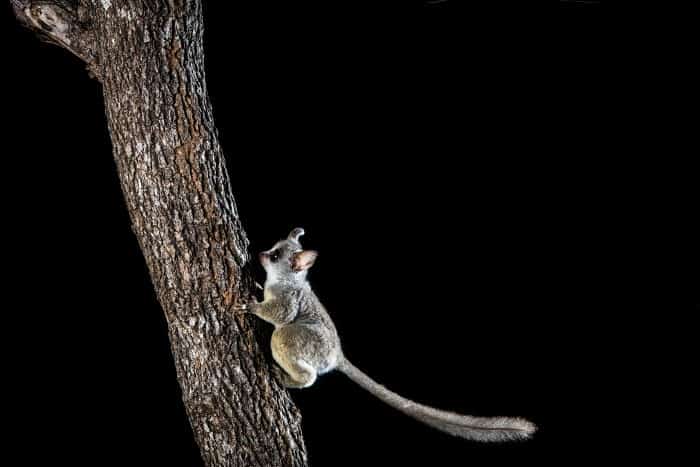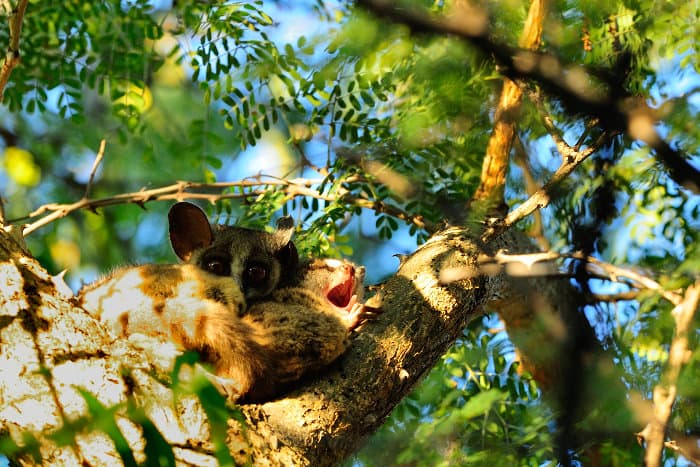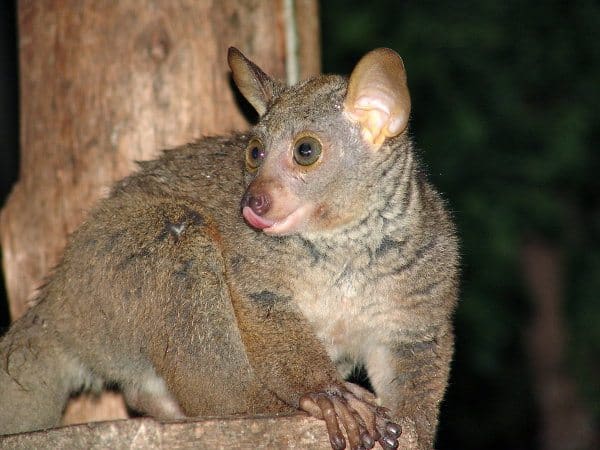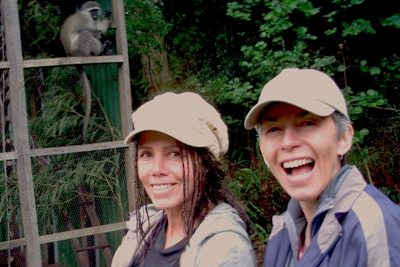Many people come to Africa in search of lions and elephants. I spent a month in Africa captivated by the bushbaby, a tiny nocturnal primate that I could always hear but rarely see.
This is a story of large eyes, nighttime missions, peculiar sounds and Mount Kilimanjaro.
It is a story of the bushbaby, one of the most incredible of all African animals.
What is the Baby of the Bush?

First some context. Let me introduce you to the animal I spent a month searching for.
Bushbabies are the smallest of all Africa’s primates. They are monkeys, except they behave completely differently to most other monkeys.
Some say they are named because they cry all night, hence being babies of the bush. In the Afrikaans language they are known as nagapies, meaning “little night monkeys.”
Their more common and scientific name is galagos, as they are members of the Galagidae family.
I didn’t know any of this when I first arrived in Tanzania. I had never even encountered an elephant, so my knowledge of smaller animals was non-existent.
But from my first evening near Moshi I was spellbound by an animal I couldn’t see.
Bushbabies Are Heard, Not Seen

I was staying in a village called Nkawanga, on the foothills of Mount Kilimanjaro, an hour north of Moshi (incidentally, a good base before going on a Tanzania safari).
On most days I could see Africa’s highest mountain, its snow-capped cone peeking out from clouds. Usually this occurred around dusk, so I would sit and read on a school playing field, waiting for Kilimanjaro to show.
An appearance from the old volcano was swiftly followed by a haunting cry from the trees behind me. It seemed that the sound was linked to the mountain.
And if that sounds stupid, you probably haven’t been an enchanted young traveler experiencing East Africa’s mystique for the first time.
Everything about Tanzania seemed magical, from Kilimanjaro to a Masai market where I sampled bull testicles.
But what was making the noise? Why did these elegiac cries accompany the mountain disappearing into golden shadow?
They were my questions and they went unanswered.
I would cross the forest when walking back to my accommodation. The evocative cries would continue, stirring my soul yet also making me jump.
“Ha ha ha” laughed the local mama who cooked my food. “They are bushbabies. Bushbabies are watching you.”
Mobile internet or Wi-Fi hadn’t reached Nkawanga back then. So I had to accept the basics of what I was told. Babies in the bush were watching me.
I later discovered a powerful bushbaby myth. Some cultures believe that this primate is so powerful it can kidnap humans.
Big Frightening Eyes Peering Through the Trees

The call of the bushbaby continued into the night. It really did sound that babies were crying. And then I glimpsed one.
Walking back through the forest I witnessed a dazzling pair of eyes. It seemed like something from the J.R.R. Tolkien book I was reading. It looked like the eyes of devil babies coming to haunt me.
Every evening I took a torch and witnessed these big frightening eyes. It took a few evenings before I realised that these were not babies, but monkeys.
Instead of watching the mountain I began searching the trees. The bushbaby is a nocturnal animal. Nobody really knows what they do during the day. Only after dark did their eyes betray them, two shimmering holes in the midst of darkness.
However, as soon as the bushbabies were illuminated by my torch, they disappeared. It took another week for me to understand how.
Bushbabies are exceptional jumpers. They are fast and agile, able to jump between trees and cling on with strong claws and nails. Each time I spotted one it would jump off effortlessly, sometimes higher into the trees.
Incredible Ears and Social Structures

It took a month but eventually I came to predict how the bushbabies would move. Sometimes I spent hours in the forest by my house, sitting patiently and listening to the clues.
Staying silent was essential. Bushbabies have enormous ears, in a way not dissimilar to bat-eared foxes. Add such brilliant hearing to nocturnal eyesight and busbabies can easily sense when danger is coming.
Gradually I came to learn their behaviour. Two bushbabies would chase each other through the trees, jumping every few seconds to a new branch.
Other bushbabies would throw things at each other, such as nuts and twigs. I had thought it a shy animal, but it was actually a highly active monkey.
And of course they would cry. A bushbaby call goes like “waow waow…waow waow.” Bushbabies call to each other to indicate their location.
At first it sounded scary. But once in the forest I grew to love this communication. It sounded like poetry floating through the trees, more like “waooooow waao, woooaaa, wow wow.”
Spending a month in a tiny village on the slopes of Mount Kilimanjaro is not a hugely social experience. I spent most evenings alone with the bushbabies and came to love the soundtrack they created.
Bushbabies have over a dozen different calls. Each has a different meaning. I could clearly distinguish aggressive calls, meek responses and happy social calls.
All the bushbabies made a similar high-pitched repetitive call when they sensed danger, including a time when I tripped over a tree branch in the dark and cried out embarrassingly.
This soundtrack grew loudest and most spectacular deep into the night. I left the windows open and shivered in the cold so I could hear it.
At the end of a nighttime feeding and socialising, bushbabies join together to produce a unique rallying call. This alerts the entire troop to come to the sleeping place and lay down for the night.
Other Bushbaby Behaviour

Since being in Tanzania I researched and discovered a lot more bushbaby behaviour. I didn’t witness any of the following behaviour. And to be very honest, it would take a lot of patience to experience it in such a reclusive, nocturnal monkey.
- Bushbabies have ears like bats, allowing them to track and snatch insects in the dark (it’s not much a jump to imagine baby snatching!).
- When jumping around forests they fold their ears back, so they are more streamlined and their ears are protected.
- Young bushbabies cannot open their eyes or move independently for the first week.
- As well as their calls, all galagos species communicate by marking their trails with urine.
- Galagos love to groom and spend a lot of the day performing social grooming. They have a pointed claw to clean their ears and groom their neck fur.
- A gestation period of 125 days usually ends in twins.
- Females will mate with many males at the same time. Males will try to mark the females by urinating on them after sex.
- Their tails are longer than the rest of their bodies.
Spotting Bushbabies on Safari

After a month in Tanzania I never witnessed a bushbaby again. No matter where I went in Africa, no matter how long I spent in the trees, those dazzling eyes would never be with me again.
I had gone to Tanzania entranced by Mount Kilimanjaro. And had left with memories of a tiny monkey that still remains mysterious to me.
Bushbabies are not only found around Kilimanjaro. They are widespread across most of Sub-Saharan Africa, one of the few species that exist in the Congo Basin, West Africa, East Africa and Southern Africa.
You could maybe see a bushbaby on safari but it is best not to look for one. Instead, listen to the calls of the forest. And if it seems that a baby is crying, go sit amid the trees and wait.



